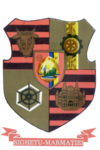| Revision as of 20:37, 27 August 2012 editRokarudi (talk | contribs)7,036 edits Audio file with Hungarian pronunciation added← Previous edit | Revision as of 20:43, 27 August 2012 edit undoRokarudi (talk | contribs)7,036 editsNo edit summaryNext edit → | ||
| Line 10: | Line 10: | ||
| |utc_offset_DST=+3 | |utc_offset_DST=+3 | ||
| |map_caption = Location of Sighetu Marmației in Romania| | |map_caption = Location of Sighetu Marmației in Romania| | ||
| |image_skyline = |
|image_skyline = Primaria sighet.jpg | ||
| |image_caption = |
|image_caption = Town Hall | ||
| |official_name=Sighetu Marmației | |official_name=Sighetu Marmației | ||
| |image_map=Sighet in Romania.png | |image_map=Sighet in Romania.png | ||
Revision as of 20:43, 27 August 2012
- "Sighet" redirects here. For the Hasidic dynasty, see Sighet (Hasidic dynasty).
| Sighetu Marmației | |
|---|---|
| Municipality | |
 Town Hall Town Hall | |
 Coat of arms Coat of arms | |
 Location of Sighetu Marmației in Romania Location of Sighetu Marmației in Romania | |
| Country | |
| County | Maramureş County |
| Status | Municipality |
| Government | |
| • Mayor | Eugenia Godja (Social Democratic Party) |
| Population | |
| • Total | 35,347 |
| Time zone | UTC+2 (EET) |
| • Summer (DST) | UTC+3 (EEST) |
| Website | http://www.primaria-sighet.ro/ |
Sighetu Marmației (Template:IPA-ro, also spelled Sighetul Marmației; Template:Lang-de or Siget; Template:Lang-hu, Hungarian pronunciation: ['maːrɒmɒroʃsiɡɛt] ; Template:Lang-sk; Template:Lang-uk; Template:Lang-yi), formerly Sighet, is a city (municipality) in Maramureş County near the Iza River, in north-western Romania.
Geography
Sighetu Marmației is situated along the Tisa river on the border with Ukraina, across from the Ukrainian town Solotvyno. Neighboring communities include: Sarasău, Săpânţa, Câmpulung la Tisa, Ocna Şugatag, Giuleşti, Vadu Izei, Rona de Jos and Bocicoiu Mare communities in Romania, Bila Cerkva community and the Solotvyno township in Ukraine (Zakarpattia Oblast). The city administers five villages: Iapa (Kabolapatak), Lazu Baciului (Bácsiláz), Șugău (Sugó), Valea Cufundoasă (Mélypatak) and Valea Hotarului (Határvölgy).
The city's name derives from the Hungarian name which means "island in Máramaros".
Demographics
The city has 35,347 inhabitants.
- Romanians - 82.2%
- Hungarians - 13%
- Ukrainians - 2.3%
- Roma - 1.5%

According to the 1910 census, the city had 21,370 inhabitants; these consisted of 17,542 (82.1%) Hungarian speakers, 2,002 (9.4%) Romanian, 1,257 (5.9%) German, and 32 Ruthenian speakers. The number of Jews was 7981; they were included in the Hungarian and German language groups. There were 5850 Greek Catholics and 4901 Roman Catholics.
History
Inhabited since the Hallstatt period, the urban area was situated on an important route that followed the Tisza Valley. The first mention of a settlement dates back to the 11th century, and the city as such was first mentioned in 1326. In 1352, it was a free royal town and the capital of Máramaros comitatus of the Kingdom of Hungary.
From 1556, the settlement - like the Castle of Huszt - was a residence of Transylvanian Princes; from 1570 to 1733, the town and the county were part of the Principality of Transylvania. In 1733, King Charles III returned it and Máramaros County to his Hungarian domain.
Sighetu Marmației was one of the Romanian, Rusyn, and Jewish cultural and political centers in the Kingdom of Hungary. The Jewish community was led by the Teitelbaum family — who also led the Satmar Hasidic community.
It became part of the Kingdom of Romania after World War I (see Greater Romania), and was again under Hungarian administration during World War II as a result of the Second Vienna Award. The latter lasted until 1944 and in these years more than 20,000 Jews from Sighet would be sent to Auschwitz (including the Nobel Peace Prize winner Elie Wiesel, born in Sighet) and other Nazi extermination camps. Nowadays there are only about 11 Jews living in Sighetu Marmației.
The Treaty of Paris at the end of World War II voided the Vienna Awards, and Sighetu Marmației returned to Romania.

Sighet prison
Main article: Sighet prisonIn the 1950s and 1960s, after the establishment of the Romanian communist regime, the Securitate ran the Sighet prison as a place for political repression of public figures who had been declared "class enemies" — the most prominent of these was the former prime minister Iuliu Maniu (who died there in 1953). The former prison is now a museum, part of the Memorial for the Victims of Communism.
Natives
- David Weiss Halivni
- Simon Hollósy
- Chaim Tzvi Teitelbaum
- Moshe Teitelbaum
- Yekusiel Yehuda Teitelbaum (I)
- Yekusiel Yehuda Teitelbaum (II)
- Elie Wiesel
- Gisella Perl
- Joseph Szigeti sometimes misspelled Sigheti
- Géza Frid
- Marius Bilaşco
- Monica Iagăr
See also
External links
- Photos and Images of Sighetu Marmaţiei
- Photos of Sighetu Marmaţiei
- Sighetu Marmaţiei
- Sighetu Marmaţiei
- Sighetu Marmaţiei Online News
- The Sighet Memorial of the Victims of Communism
References
- 2011 census data
- Atlas and Gazetteer of Historic Hungary 1914, Talma Kiadó ISBN 963-85683-4-8
